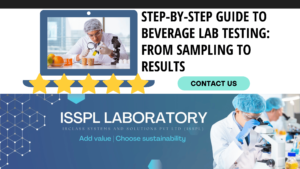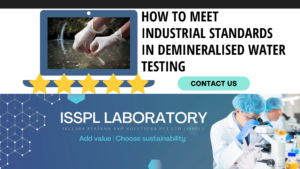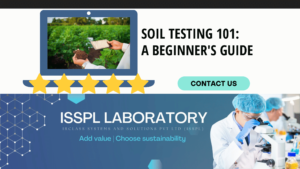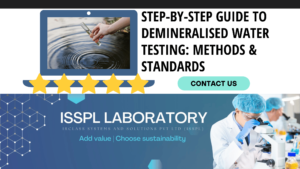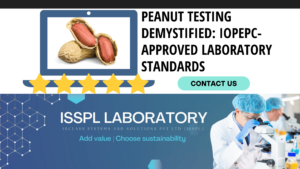An Overview by Team ISSPL - Analytical Testing Laboratory in India
ToggleWater quality is an integral matter and quite complex. Determining the quality of the surface water and other sources of water is integral for multiple reasons. The process of assessing water quality involves the checking of physical, chemical, hydrological, and biological characteristics. It also includes complex procedures.
The definition of water quality defines it as the amalgamation of physical, chemical, and biological characteristics of water. All these attributes define and determine the acceptability of water for diverse applications. For instance, drinking water must be pure, wholesome, and drinkable.
In contrast, the water for irrigation may contain dissolved solids and minerals. But there must be no toxicants. Also, outdoor bathing pathogens are critical for water quality in various industrial applications. It needs to be controlled accordingly. Textiles, paper, brewing, and other industries use water with specific water quality requirements.
Water testing and monitoring – The strategy
One can spot multiple economic and practical considerations related to water testing and monitoring network design. It involves sampling frequencies, variable choices, and difference frequencies of laboratory analysis.
All these determine the suitability of the hydraulic and hydrologic constraints and variability in the water body sample. It is critical to manage the testing efforts and obtain accurate information.
The scoping and designing step for the water testing forms the foundation of the water quality monitoring program.
The objective of the design is to reduce the cost of monitoring without compromising the essentialities and information. An optimized water quality monitoring program must be based on the following –
- Water quality issues
- Relevant background information
- Assessment objectives
- Ideal outcomes
- Suitable methods
- Dynamics of the surface-level water systems
The need for initial surface-level testing
Most people overlook the need to review water quality at the initial stage. For instance, a new well needs to be tested before using them. It is critical to identify pre-existing problems and ensure water suitability. The application can be diverse. It can be for drinking, watering plants, irrigation, etc. Initial testing helps track changes over time.
This way, you can determine the best water quality testing program that suits your unique environment. With the optimal parameters, you can judge the effectiveness of the water treatment and assessment plan.
Professionals can help you make the best choice. They have an overview of the critical aspects that matter significantly. For instance, water potability testing is essential for reviewing coliform bacteria, sodium, chloride nitrates, sulfate, improper pH, manganese, iron, water hardness, and other dissolved solids in the water. Coliform bacteria are toxic microorganisms that affect human health.
Extensive nitrate concentration in the water can restrict the ability to carry oxygen in blood. Sodium, iron, sulfate, manganese, chloride, etc., are dissolved solids that make the water taste and smell foul. Hence, you can realize the impact of various minerals and metals in the water. Professional testers can review the diverse aspects and propose the ideal testing solution. It ensures optimal suitability of the testing report for surface water level.
All about surface water assessment
Surface water monitoring is an extensive process of assessing the overall quality of water. One can identify the water pollutants that may damage aquatic life and adversely impact the environment. It is an integral aspect of environmental protection and management.
The water on the Earth’s surface, like rivers, lakes, ponds, and other water bodies is termed Surface water. The surface water monitoring process includes the collection and analysis of water samples from more than one water body. The samples collected at regular intervals need to be analyzed for diverse parameters.
The testing parameters include – temperature, pH level, dissolved oxygen, turbidity, and nutrients. Reviewing these parameters helps identify the changes in water quality. With the reports, you can detect potential environmental issues.
Characteristics that make an impact
Surface water quality assessment focuses on the physical, chemical, and biological characteristics of surface water bodies. The testing measures help determine the overall health and suitability of the water for various uses. It can be for drinking, irrigation, and aquatic life support.
The assessment involves collecting water samples from the different surface water bodies and reviewing them in the best-in-class laboratory facilities. It is critical to determine the presence and levels of various contaminants like nutrients, metals, pathogens, and organic pollutants in the surface water body sample.
Based on the results of the assessment, appropriate measures could be conveniently taken to safeguard and enhance water quality. The appropriate measures can be diverse. It can be pollution control measures, development of wastewater treatment systems, or employing enhanced land use practices. The Surface water quality assessments are ideal for establishing regulatory norms and guidelines for surface water quality management.
The diverse factors affecting surface water quality are mostly human activities like – agriculture, urbanization, industrial processes, and wastewater discharges. As a result, the water quality assessment steps have become critical to review the contamination sources. Make informed choices and take corrective actions to safeguard public health and the environment.
Abide by the regulatory norms.
Surface water quality standards are defined by the guidelines set by popular regulatory agencies. They help protect the quality of surface water bodies and ensure the best usability. The standards outline the acceptable levels of the different types of physical, chemical, and biological parameters in surface water samples.
The parameters can include dissolved oxygen, pH, turbidity, bacteria, and toxic pollutants. The standards ensure that surface water is apt for drinking, recreation, aquatic life support, and other uses. These depend on scientific studies and risk assessment reports. The globally accepted standards get enforced through various mechanisms, like – permits, regulations, monitoring programs, etc.
Summing note
The objective of surface water monitoring is to ensure the safety of the water in use. It makes the water safe for human use and aquatic life. Water quality detection at different surface levels is integral for human activities like – agricultural practices, urban development, and industrial processes. Make an informed choice with the best testing facilities at world-class laboratories and ensure water safety for diverse utilities.
